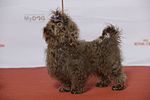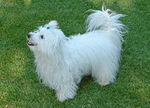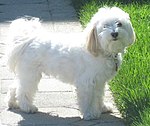
A Bichon Frisé is a small breed of dog of the bichon type.

The Serbian Tricolour Hound is a breed of scent hound from Serbia.

Maltese dog refers both to an ancient variety of dwarf, white-coated dog breed from Italy and generally associated also with the island of Malta, and to a modern breed of similar dogs in the toy group, genetically related to the Bichon, Bolognese, and Havanese breeds. The precise link, if any, between the modern and ancient species is not known. Nicholas Cutillo suggested that Maltese dogs might descend from spitz-type canines, and that the ancient variety probably was similar to the latter Pomeranian breeds with their short snout, pricked ears, and bulbous heads. These two varieties, according to Stanley Coren, were perhaps the first dogs employed as human companions.

The Pyrenean Sheepdog, the Chien de Berger des Pyrénées in French, is a small to medium-sized breed of herding dog from the Pyrenees Mountains region of France. It is found herding flocks of sheep throughout the Pyrenees alongside the much larger Pyrenean Mountain Dog which is kept as a flock guardian.
Rat terrier Toy dog traditionally refers to a very small dog or a grouping of small and very small breeds of dog. A toy dog may be of any of various dog types. Types of dogs referred to as toy dogs may include spaniels, pinschers and terriers that have been bred down in size. Not all toy dogs are lap dogs.

A lap dog or lapdog is a dog that is both small enough to be held in the arms or lie comfortably on a person's lap and temperamentally predisposed to doing so. Lapdog is not a specific breed, but a generic term for a type of dog that is small in size and friendly towards humans.

The Havanese, a bichon-type dog, is the national dog of Cuba, developed from the now extinct Blanquito de la Habana. The Blanquito descended from the also now-extinct Bichón Tenerife. It is believed that the Blanquito was eventually cross-bred with other bichon types, including the poodle, to create what is now known as the Havanese. They are sometimes referred to as "Havana Silk Dogs", but this is a separate breed, which has been bred to meet the original Cuban standards.

The Coton de Tuléar is a breed of small dog named for the city of Tuléar in Madagascar. This breed is thought to have originated from a group of small white dogs that swam across the Malagasy channel following a shipwreck. Known for its cotton-like coat, the Coton de Tuléar typically grows to no more than 18 pounds (8.2 kg), and are white, sometimes with grey, tan, black, or tri-colored markings. The Coton de Tuléar Day is celebrated on November 26.

The Grand Bleu de Gascogne is a breed of hounds of the scenthound type, originating in France and used for hunting in packs. Today's breed is the descendant of a very old type of large hunting dog, and is an important breed in the ancestry of many other hounds.

The Bolognese is a small dog breed of the bichon type, originating in Italy. The name refers to the northern Italian city of Bologna. It is part of the toy dog group and is considered a companion dog.

The Chortai, sometimes spelt Chortaj, is a breed of sighthound from Ukraine.

The Billy is a large scenthound originating from central western France.
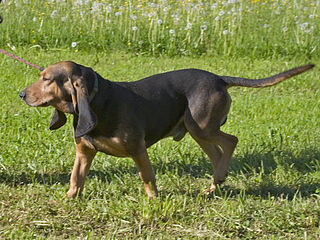
The Bruno Jura Hound is a breed of scenthound from the Jura Mountains on the French-Swiss border.

The Russian Tsvetnaya Bolonka, also known as the Bolonka Zwetna in Germany, or known simply as a Bolonka is a rare toy breed of the Bichon type, developed in Moscow and Saint Petersburg, Russia, from the ancestors of smaller dogs such as the Bichon Frise, Toy Poodle, Shih Tzu, Pekingese and French Bolognese. They include the white variety, the Franzuskaya Bolonka. The name of the breed means French lap dog.
The St. Hubert Jura Hound is a breed of scenthound originating in the Jura Mountains on the French-Swiss border.
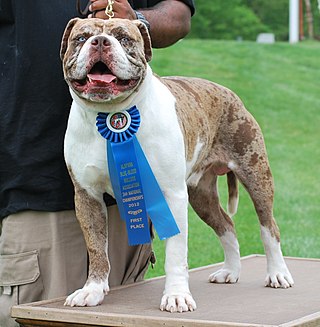
The Alapaha Blue Blood Bulldog is a breed of bulldog from the United States, and it is predominantly used as a guard dog. It is a very powerful, muscular breed with large head and brachycephalic muzzle. The hair coat is short, typically colored white with black, blue, buff or brown patches, and its tail is kept un-docked. Sexual dimorphism is common in the breed, with larger dogs typically twice the weight of smaller bitches.
The Norman Hound is a now extinct breed of scent hound from France.

Bassets are a sub-type of scenthound deliberately bred with short legs, that are used for hunting where the hunters accompany the hunting hounds on foot.



